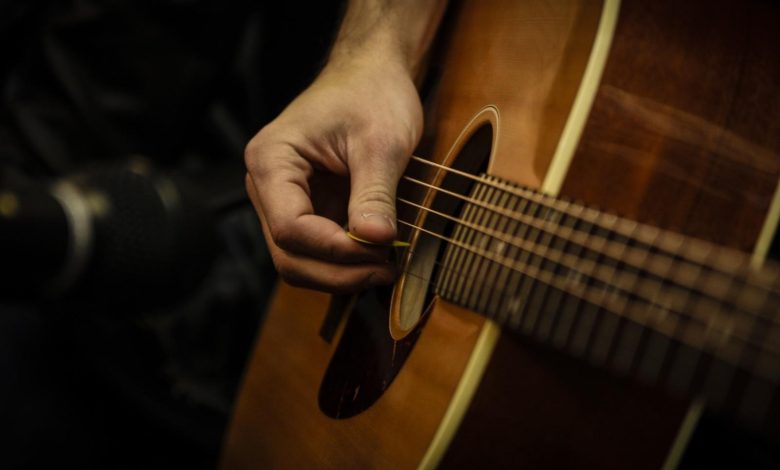How to Play Acoustic Guitar Unlimited Guide 2022

You’re here because you want to know how to play acoustic guitar. And that’s great! The acoustic guitar is a beautiful instrument that can be used for a variety of genres, from country to rock to pop. But before you can start playing your favorite songs, you need to learn the basics. Here’s a quick guide on how to play acoustic guitar for beginners. We’ll cover everything from how to hold the instrument and basic chords, to strumming techniques and melodies.
Guide For Playing An Acoustic Guitar:
Assuming you have an acoustic guitar, the first step is to practice at home. Start by learning the basic chords and work your way up to more advanced techniques.
In addition to practicing at home, it is also important to get out and play as often as possible. Join a band or attend open mic nights at local coffeehouses and music venues. The more you play, the better you will become at reading music and playing your instrument.
Finally, don’t be afraid to experiment with your acoustic guitar. Try different strumming patterns, and picking styles, and even add in some percussive elements such as tapping or slapping. By exploring all that your guitar can do, you’ll be able to find your own unique sound and style.
Find The Suitable Sitting:
In order to get the best possible sound out of your acoustic guitar, it is important that you find a comfortable sitting position. The most common way to sit while playing guitar is with the instrument resting on your right thigh, with the neck pointing towards your left.
Once you have found a comfortable position, it is important to maintain good posture. Sit up straight and avoid slouching. This will help you avoid injuries and will also make it easier to reach the strings.
If you are having trouble finding a comfortable position, there are a few things you can try. Adjusting the height of your chair or stool can often make a big difference. You can also experiment with different positions for your arms and hands.
Finally, don’t forget to practice! The more time you spend playing guitar, the more comfortable you will become in any position.
The Second Step
The second step in playing acoustic guitar is to learn the chords. A chord is simply two or more notes played together. There are many different chords, and you need to know how to finger them correctly on the fretboard. You can find chord diagrams online or in guitar magazines. Once you know how to finger the chords, you need to practice switching between them. Start by playing a simple song that uses only a few chords. As you get comfortable with switching between chords, you can start adding more complex songs to your repertoire.
The Strumming Technique
There are different ways to hold a pick, but the most common is to hold it between your thumb and first two fingers. You can also try holding it between your thumb and middle finger.
When you strum, you don’t just want to move your arm up and down. You also want to loosen or tighten your grip on the pick. This will give you different sounds. For example, a softer sound happens when you strum with an almost completely loose grip and a harder sound happens when you strum with a tight grip.
You can experiment with different techniques to find what works best for you, but here are a few tips:
-Use an up-and-down motion rather than side-to-side.
-Keep your wrist relaxed and let your arm do most of the work.
-Don’t press too hard on the strings; let the pick do the work.
The most important thing is to practice and get comfortable with the technique. The more you play, the easier it will become
Main Parts of an Acoustic Guitar

An acoustic guitar is made up of several different parts, all of which work together to create the beautiful sound that we know and love. The main parts of an acoustic guitar are:
-The body
-The neck
-The headstock
-The strings
-The bridge
Body
Learning how to play acoustic guitar can be a daunting task, especially if you’re a beginner. But with this unlimited guide, you’ll be playing like a pro in no time!
This guide will teach you everything you need to know about playing acoustic guitar, from the basics of holding the instrument and plucking the strings to more advanced techniques like strumming and finger-picking. You’ll also learn about different genres of music that can be played on acoustic guitar, and how to read chord charts and tablature.
By the end of this guide, you’ll be able to play any song you want on acoustic guitar. So what are you waiting for? Grab your guitar and let’s get started!
Sound Hole
The sound hole is the circular opening on the face of the guitar that emits sound. The size and shape of the sound hole affect the tone of the guitar. A smaller sound hole will result in a brighter, thinner sound, while a larger sound hole will result in a fuller, richer sound.
To play acoustic guitar, you will need to place your left-hand fingers just inside the sound hole and pluck the strings with your right hand. You can also use a pick to strum the strings. Experiment with different techniques to find what sounds best to you.
Bridge
If you want to play acoustic guitar, you’ll need to start by learning how to build a basic foundation. And that starts with the bridge. The bridge is the part of the guitar that helps support the strings and transfers their vibrations to the body of the instrument. It’s also where you’ll rest your picking hand when you’re playing.
There are two main types of bridges for acoustic guitars: fixed and floating. A fixed bridge is attached to the body of the guitar, while a floating bridge is not. Both have their pros and cons, so it’s ultimately up to you which type you prefer.
Building a good foundation starts with choosing the right bridge for your guitar. So take some time to familiarize yourself with the different types of bridges and find one that suits your playing style and needs.
Neck and Fretboard
The neck of the guitar is one of the most important parts of the instrument. The fretboard is a thin, flat piece of wood that sits on top of the neck. It is where your fingers press down on the strings to create sound.
There are many different types of acoustic guitars, but they all have one thing in common: the neck and fretboard. In this section, we’ll show you how to choose the right neck and fretboard for your guitar-playing style. We’ll also give you some tips on how to care for your neck and fretboard so that they last for years to come.
Headstock and Machine Heads
Assuming you are looking at an acoustic guitar with steel strings and a right-handed orientation (i.e. the low E string is on the left side when you are looking down at the guitar in the playing position), the headstock is located at the top of the neck where it meets the body. The machine heads (or tuning pegs) are located on the headstock and are used to tune the strings.
The first thing you need to do when tuning your guitar is to loosen all of the strings. This can be done by turning each machine head counter-clockwise until there is a significant amount of slack in the string. You should then pluck each string individually to ensure that it is loose.
Once all of the strings are loosened, you can begin tuning them to the correct pitches. For reference, here are the standard tuning pitches for an acoustic guitar:
Low E – 82 Hz
A – 110 Hz
D – 147 Hz
G – 196 Hz
B – 247 Hz
High E – 329 Hz
To tune each string, start by plucking it gently and then turn the corresponding machine head clockwise or counter-clockwise until you hear a pitch that matches one of those listed above. It’s important to make sure that you’re turning the machine head in the correct direction; if you turn it too far in one direction, you’ll just end up having to turn it, even more, to get back to where you started!
What are the notes of a guitar string?
Each note on a guitar string is produced by plucking the string with your finger and then striking the string with your pick. The pitch of the note depends on the tension of the string, which is determined by the length of the string. The shorter the string, the higher the pitch.




